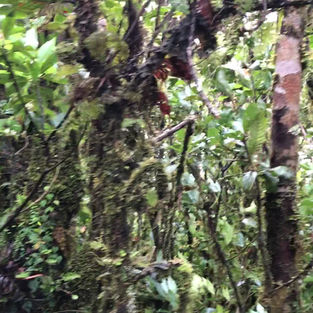
National Science Foundation Project
Lichens of the Southern Philippines
Read the official project abstracts: DEB 1754697 (PI: Peter Fritsch, co-PI Manuela Dal Forno; BRIT) and DEB 1754667 (PI: Darin Penneys; UNC)
For more information, vouchers and literature of Filipino material, please contact me at mdalforno@brit.org
The Philippines is home to over one thousand species of lichens. The natural biota of this biodiversity hotspot is critically threatened by habitat loss, yet its funga and flora remain poorly known and many species await initial discovery and description. This multi-year NSF project aims to conduct several expeditions throughout the southern Philippines, i.e., Mindanao and the Visayas, to document this plant and lichen diversity. Vouchers of lichens, bryophytes, and vascular plants are being collected, digitized and made freely available on various online sites. DNA extractions are being made for most lichen collections, with the objective of creating integrative taxonomic and floristic accounts, and the occurrence and molecular data will be used to characterize patterns of species richness, endemism, and biogeography. In addition to publications, these data will also be used to inform and direct conservation priorities with local authorities and communities.
The Philippines consists of over 7500 islands broadly divided into three main geographical regions: Luzon (north), Visayas (central), and Mindanao (south). Our program aims to document plant and lichen diversity in the southern portion of this archipelagic country through multiple major and minor expeditions from 2019 until 2023. Each field excursion will include international and Filipino professionals and students, as well as many local members of the communities visited.
Short-Term Goals:
-
To collect, document and identify plants and lichens via expeditions
-
To visit previously unexplored areas in the Southern Philippines
-
To digitize and disseminate botanical information
-
To create a bank of plant and lichen images
-
To extract and sequence the DNA of lichen specimens
-
To incorporate thousands of new vouchers into multiple herbaria around the world
Long-Term Goals:
-
To describe all new species discovered and report new records
-
To produce monographs of focal groups
-
To investigate relationships of Filipino species within broad phylogenetic frameworks
-
To create a DNA bank of Filipino lichens with at least 500 species
-
To characterize patterns of species richness and endemism across the region
-
To test the effect of Pleistocene land conformations on the Philippine flora and funga
Previous expeditions:
Expedition 1 (June 2019): Marilog Forest Reserve, Mt. Limbawon and Mt. Hamiguitan (all in Mindanao); Mt. Ilihan and Timpoong and Hibok-Hibok Natural Monument (both in Camiguin Island). Lichens collected: 959 samples.
Expedition 2 (December 2019): Balinsasayao Twin Lakes Natural Park and Cuernos de Negros (both in Negros Island); and Marilog Forest Reserve (Mindanao). Lichens collected: 1617 samples.
Expedition 3 (July 2022): Mt. Malimumu, Natampod and Mt. Apo (Mindanao). Lichens collected: 3121 samples.
Expedition 4 (January 2023): Mt. Balatukan, Mt. Nebo and Mt. Musuan (Mindanao) and Dinagat Islands (Bababu Lake, Loreto and Paragua). Lichens collected: 3324 samples.
Expedition 5 (July 2023): Mt. Nebo (Mt. Kalatungan Range Natural Park), Cinchona Forest Reserve (Mt. Kitanglad Range Natural Park), and Talangisog Forest Park and View Point (all in Mindanao). Lichens collected: 4312 samples.
Expedition 6 (June 2024): Mt. Talomo and Lilingayon (Mindanao) and Dinagat Islands (Loreto and Mt. Palhi).
Former and current "Lichen Team" members of this project: Dr. Alice Gerlach (BRIT), Dr. Arman De La Peña Nuezca (CMU), Aurfeli D. Nietes (UPLB), Dr. Bibiana Moncada (BGBM), Ermalene C. Taer (CMU), Franchesca C. Vega (MSU-IIT), Ivy Adlaon (CMU), Jayson Pucot (DSSC), MSc Jovi Nobleza (CMU), Dr. Manuela Dal Forno (BRIT), Qweenie P. Abaya (CMU), MSc Rasel Lacandula (CMU), MSc Yvonne Love Cariño (CMU).
The project also has two Bryophyte Teams, a Fern Team and two Seed Plants Teams!
Main institutions Involved:
In the Philippines: Central Mindanao University, University of the Philippines-Manila, Bukidnon State University, Davao del Sur State College, University of the Philippines-Los Baños, University of Southeastern Philippines, National Museum of the Philippines, Department of Environment and Natural Resources
Outside of the Philippines: Fort Worth Botanic Garden | Botanical Research Institute of Texas, University of North Carolina-Wilmington, Southern Illinois University Carbondale, California Academy of Sciences, Missouri Botanical Garden, Botanischer Garten, Freie Universität Berlin, University of California Botanical Garden, Smithsonian's National Museum of Natural History.








Bridge in Cinchona Forest Reserve – Collecting lichens up in the canopy! Samples drying naturally.


























